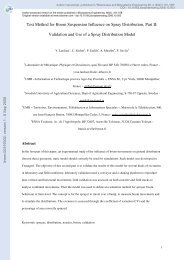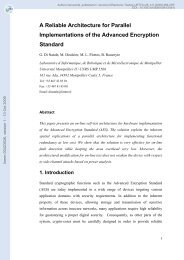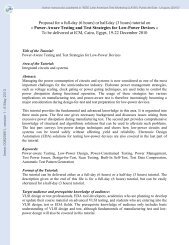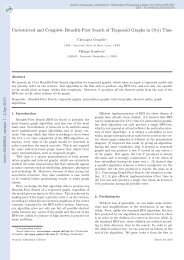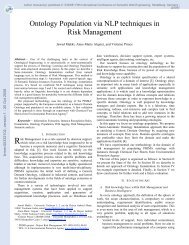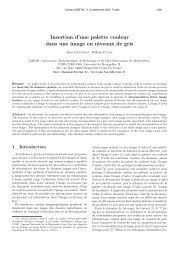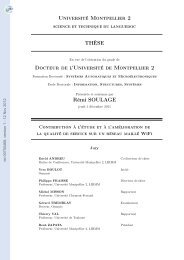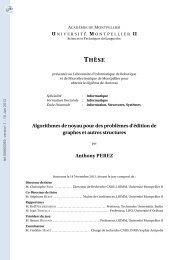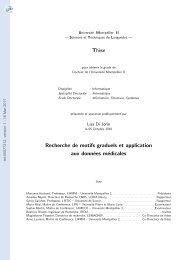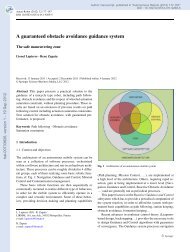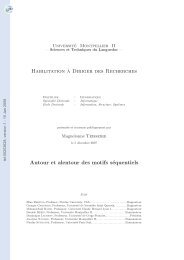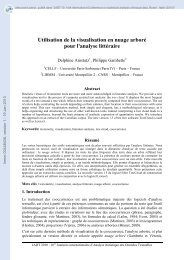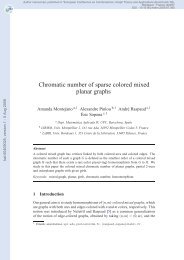FMA & HMTP Portal in OWL - HAL - LIRMM - CNRS
FMA & HMTP Portal in OWL - HAL - LIRMM - CNRS
FMA & HMTP Portal in OWL - HAL - LIRMM - CNRS
You also want an ePaper? Increase the reach of your titles
YUMPU automatically turns print PDFs into web optimized ePapers that Google loves.
<strong>FMA</strong> & <strong>HMTP</strong> <strong>Portal</strong> <strong>in</strong> <strong>OWL</strong>: Reconcil<strong>in</strong>g Ontology<br />
with Term<strong>in</strong>ology <strong>in</strong> Life Sciences via Metamodel<strong>in</strong>g<br />
C. Golbreich 1 , J. Grosjean 2 , S.J. Darmoni 2<br />
1 <strong>LIRMM</strong> <strong>CNRS</strong> 5506, Montpellier & University Versailles Sa<strong>in</strong>t-Quent<strong>in</strong>, France<br />
2 CISMEF & TIPS LITIS EA 4108, Rouen University Hospital, Rouen, France<br />
cgolbrei@gmail.com, Julien.Grosjean@chu-rouen.fr, Stefan.Darmoni@chu-rouen.fr<br />
Abstract. The aim is to highlight how it is possible to reconcile ontologies and<br />
term<strong>in</strong>ologies <strong>in</strong> Life Sciences via metamodel<strong>in</strong>g. The paper focuses on the<br />
Foundational Model of Anatomy (<strong>FMA</strong>). The first part describes the <strong>FMA</strong><br />
ontology formalization <strong>in</strong> <strong>OWL</strong> 2. The second part presents the Health Multi-<br />
Term<strong>in</strong>ologies <strong>Portal</strong> (<strong>HMTP</strong>) of French term<strong>in</strong>ologies implemented <strong>in</strong> <strong>OWL</strong>.<br />
It expla<strong>in</strong>s how its <strong>FMA</strong> term<strong>in</strong>ology was obta<strong>in</strong>ed from the <strong>FMA</strong> ontology by<br />
reification. The <strong>FMA</strong> ontology and term<strong>in</strong>ology illustrate how ontologies and<br />
term<strong>in</strong>ologies can be made compatible via metamodel<strong>in</strong>g. Advantages and<br />
possible means to b<strong>in</strong>d the two views even more closely are discussed <strong>in</strong><br />
conclusion. To the best of our knowledge, no complete representation of the<br />
<strong>FMA</strong> ontology and term<strong>in</strong>ology <strong>in</strong> <strong>OWL</strong> 2 existed so far.<br />
Keywords: Ontology, Term<strong>in</strong>ology, Controlled Vocabulary, Metamodel<strong>in</strong>g,<br />
<strong>OWL</strong>, <strong>Portal</strong>, Brows<strong>in</strong>g, Index<strong>in</strong>g; Life Sciences, Health, Anatomy.<br />
1 Introduction<br />
‘Ontologies’ and ‘Term<strong>in</strong>ologies’ both refer to vocabularies, but their concern and<br />
purposes are different. The former deal with knowledge describ<strong>in</strong>g the entities<br />
(concepts) of a doma<strong>in</strong> of <strong>in</strong>terest, the later do not describe the doma<strong>in</strong> but provides<br />
<strong>in</strong>formation about the terms (words) used <strong>in</strong> the doma<strong>in</strong> (though sometimes the<br />
dist<strong>in</strong>ction might be blurred or the two notions may overlap, e.g. SNOMED-CT [13]).<br />
“Ontologies are formalized vocabularies of terms, often cover<strong>in</strong>g a specific doma<strong>in</strong><br />
and shared by a community of users” [1]. They specify the mean<strong>in</strong>gs of terms by<br />
describ<strong>in</strong>g their relationships with other terms <strong>in</strong> the ontology. For example, the<br />
Foundational Model of Anatomy (<strong>FMA</strong>), “a reference ontology about human<br />
anatomy” [2] specifies the anatomical structures by their relationships with other<br />
<strong>FMA</strong> entities, <strong>in</strong>dicat<strong>in</strong>g their regions, constituents, <strong>in</strong>nervations, blood vessels,<br />
boundaries etc., e.g.; a Heart is composed of two regions - its left and right side -, has<br />
several constitutional parts – Wall of Heart, Interatrial, Interventricular, and<br />
Atrioventricular septum, Mitral Valve, etc. -, is <strong>in</strong>nerved by the Deep cardiac plexus,<br />
Right and Left coronary nerve plexus, etc.<br />
1
The number of biomedical ontologies is <strong>in</strong>creas<strong>in</strong>g, rang<strong>in</strong>g from anatomy,<br />
genomics, experimental conditions, imag<strong>in</strong>g, chemistry etc., e.g., Gene Ontology 1 ,<br />
SNOMED-CT.<br />
While a formal ontology provides the mean<strong>in</strong>gs of terms as axioms and facts, a<br />
term<strong>in</strong>ology is of completely different nature. Term<strong>in</strong>ologies do not formalize the<br />
mean<strong>in</strong>gs of terms, but state what are the language terms used <strong>in</strong> a doma<strong>in</strong> of <strong>in</strong>terest<br />
and tell <strong>in</strong>formation (data) about them, such as the preferred term, synonyms, broader,<br />
narrower terms. They consist at m<strong>in</strong>imum, of a controlled vocabulary and a system of<br />
identifiers 2 . Identifiers are the primary means of referr<strong>in</strong>g to the vocabulary units, e.g.<br />
CUI (Concept Unique Identifiers) <strong>in</strong> the UMLS [14], ID <strong>in</strong> SNOMED CT. They are<br />
associated with a ‘label’ <strong>in</strong> natural language <strong>in</strong>tended for communication with<br />
humans. For example <strong>in</strong> MeSH 3 , the descriptor (MeSH Head<strong>in</strong>g) identified by the<br />
Unique ID D009203, has Myocardial Infarction as label,: Myocardial<br />
Infarct as synonym, is associated to other terms (See Also): Heart Rupture,<br />
Post-Infarction, and can be affiliated with various subhead<strong>in</strong>gs (MeSH<br />
Qualifiers), e.g. diet therapy, diagnosis etc. Terms are usually organized<br />
<strong>in</strong>to hierarchies. But their hierarchical l<strong>in</strong>ks, e.g. broader, narrower, do not have any<br />
formal semantics and should not be confused with a subclass relationship. They may<br />
for <strong>in</strong>stance denote whole-part relations. These l<strong>in</strong>ks are <strong>in</strong>tensively used to search<br />
and browse term<strong>in</strong>ologies.<br />
The UMLS (Unified Medical Language System) <strong>in</strong>cludes more than 130 health<br />
term<strong>in</strong>ologies, some <strong>in</strong> multiple languages, e.g., SNOMED Cl<strong>in</strong>ical Terms<br />
(SNOMED CT), MeSH (Medical Subject Head<strong>in</strong>gs), ICD 10 (International Statistical<br />
Classification of Diseases and Related Health Problems) 4 , HL7 (Health Level Seven<br />
Vocabulary), HUGO (Gene Nomenclature Database), WHOART (WHO Adverse<br />
Drug Reaction Term<strong>in</strong>ology), etc.<br />
<strong>OWL</strong> ontologies and term<strong>in</strong>ologies have different advantages. While ontologies<br />
provide knowledge useful to support ontology reason<strong>in</strong>g, design and ma<strong>in</strong>tenance,<br />
query<strong>in</strong>g or m<strong>in</strong><strong>in</strong>g data, semantic annotation, health term<strong>in</strong>ologies are extensively<br />
used for resources <strong>in</strong>dex<strong>in</strong>g and retrieval, and for cod<strong>in</strong>g systems. For example, the<br />
classical utilization of SNOMED-CT is to use its catalogue and codes to <strong>in</strong>dex<br />
medical records. In short, ontologies and term<strong>in</strong>ologies have different nature and<br />
purposes: an ontology is a doma<strong>in</strong> model that br<strong>in</strong>gs a clear semantics and reason<strong>in</strong>g<br />
support, whereas a term<strong>in</strong>ology is a metamodel of a doma<strong>in</strong> ontology; and supports<br />
powerful <strong>in</strong>dex<strong>in</strong>g and search.<br />
The goal is to reconcile these two complementary views and to comb<strong>in</strong>e their<br />
advantages. The paper presents a first step achieved <strong>in</strong> that direction for the<br />
Foundational Model of Anatomy (<strong>FMA</strong>). Section 2 first describes the <strong>FMA</strong> ontology<br />
formalization <strong>in</strong> <strong>OWL</strong> 2 and the <strong>FMA</strong>-<strong>OWL</strong>izer tool developed for it. Section 3 then<br />
presents the Health Multi-Term<strong>in</strong>ologies <strong>Portal</strong> (<strong>HMTP</strong>) of French term<strong>in</strong>ologies<br />
implemented <strong>in</strong> <strong>OWL</strong> and its <strong>FMA</strong> term<strong>in</strong>ology obta<strong>in</strong>ed from the <strong>FMA</strong> ontology. All<br />
along, <strong>FMA</strong> examples illustrate how metamodel<strong>in</strong>g allows reconcil<strong>in</strong>g term<strong>in</strong>ologies<br />
1 http://www.geneontology.org/<br />
2http://ec.europa.eu/<strong>in</strong>formation_society/activities/health/docs/publications/2009/2009semantic -health-report.pdf<br />
3 http://www.nlm.nih.gov/mesh/<br />
4 http://apps.who.<strong>in</strong>t/classifications/apps/icd/icd10onl<strong>in</strong>e/<br />
2
and ontologies. The <strong>FMA</strong> term<strong>in</strong>ology is a metamodel of the <strong>FMA</strong> ontology, which is<br />
represented by an <strong>OWL</strong> ontology (<strong>FMA</strong>-TERM) that stores facts about the terms used<br />
to denote the entities of the <strong>FMA</strong> ontology (<strong>FMA</strong>-<strong>OWL</strong>); Reversely, the <strong>FMA</strong><br />
ontology metadata are represented by <strong>OWL</strong> 2 annotation of annotations. Advantages<br />
and possible means to b<strong>in</strong>d the two even more closely are f<strong>in</strong>ally discussed.<br />
2 <strong>FMA</strong> Ontology <strong>in</strong> <strong>OWL</strong> 2<br />
The <strong>FMA</strong> ontology is <strong>in</strong>tended to model canonical human anatomy that is, “the ideal<br />
or prototypical anatomy to which each <strong>in</strong>dividual and its parts should conform” [2]<br />
[3]. It conta<strong>in</strong>s more than 85,000 classes, 140 relationships connect<strong>in</strong>g the classes and<br />
over 120,000 terms. The <strong>FMA</strong> describes anatomical entities, most of which are<br />
anatomical structures composed of many parts <strong>in</strong>terconnected <strong>in</strong> complex ways. It is a<br />
very large and perhaps one of the most complex ontology <strong>in</strong> the biomedical sciences.<br />
<strong>OWL</strong> 2 is the W3C standard for ontologies on the Semantic Web. <strong>OWL</strong> 2 provides<br />
several advantages for Life Sciences ontologies: <strong>in</strong>teroperability, semantics, reason<strong>in</strong>g<br />
services. (1) Interoperability is important for shared use across different biological<br />
and medical doma<strong>in</strong>. Once converted to <strong>OWL</strong> 2, ontologies become easier to be<br />
connected or comb<strong>in</strong>ed with other ontologies. (2) Semantics (mean<strong>in</strong>g) of terms is<br />
formally specified thanks to the underly<strong>in</strong>g description logics. (3) Another major<br />
practical benefit is that it allows to exploit the multitude of exist<strong>in</strong>g <strong>OWL</strong> tools, <strong>in</strong><br />
particular powerful reasoners. For example, the <strong>FMA</strong> <strong>in</strong> <strong>OWL</strong> 2 makes it<br />
<strong>in</strong>teroperable with other life sciences ontologies, provides a formalized vocabulary of<br />
anatomy with a precise mean<strong>in</strong>g of terms, supports reason<strong>in</strong>g, which is crucial for its<br />
design, ma<strong>in</strong>tenance, and quality <strong>in</strong>surance. <strong>OWL</strong> 2 higher expressiveness, <strong>in</strong><br />
particular its metamodel<strong>in</strong>g abilities, is also of major <strong>in</strong>terest for conciliat<strong>in</strong>g<br />
ontologies and term<strong>in</strong>ologies, as shown next.<br />
The <strong>FMA</strong> ontology is implemented <strong>in</strong> Protégé frames 5 and stored <strong>in</strong> a MySQL<br />
database backend. Transform<strong>in</strong>g it <strong>in</strong>to <strong>OWL</strong> 2 is not a simple translation. It requires<br />
to specify the mean<strong>in</strong>g of terms <strong>in</strong> logics and to express anatomical knowledge, which<br />
was not explicit, by logical statements (axioms). This raises several issues. First,<br />
different types of <strong>in</strong>formation are embedded <strong>in</strong> Protégé <strong>FMA</strong>. Apart from the doma<strong>in</strong><br />
knowledge concern<strong>in</strong>g the anatomical entities, the <strong>FMA</strong> <strong>in</strong>cludes meta-level<br />
knowledge. The problem is that <strong>in</strong>terpret<strong>in</strong>g both knowledge <strong>in</strong> the same model might<br />
lead to undesired consequences because of their <strong>in</strong>teractions. Two solutions are<br />
proposed: an <strong>OWL</strong> 1 DL ontology without metaclasses and an <strong>OWL</strong> 2 ontology with<br />
metaclasses (§2.1). A second challenge is to provide formal def<strong>in</strong>itions and axioms<br />
that are semantically correct from an anatomical viewpo<strong>in</strong>t. The idea is to use lexical<br />
patterns for it (§2.2). Thirdly, given the large size of the <strong>FMA</strong>, it is essential to<br />
automatically generate the <strong>OWL</strong> axioms. A highly flexible tool (§2.4) enables to<br />
create not only a s<strong>in</strong>gle ontology but several ‘<strong>FMA</strong>-<strong>OWL</strong>’ customized variants (§2.3).<br />
5 the frame-based system developed by Stanford Center for Biomedical Informatics Research<br />
3
2.1 Metamodel<strong>in</strong>g<br />
Protégé Metaclasses. In <strong>FMA</strong> Protégé frames each anatomical entity is modeled<br />
both as a class and a metaclass 6 . At the doma<strong>in</strong> level, classes describe the anatomical<br />
entities. At the meta-level, metaclasses serve several purposes. They associate<br />
metadata to the anatomical entities, for example they attach to the class Heart its<br />
author ‘JOSE MEJINO, MD’, preferred-terms ‘Heart’ <strong>in</strong> English, ‘Cor’ <strong>in</strong> Lat<strong>in</strong>, Non-<br />
English equivalent ‘coeur’ <strong>in</strong> French, its def<strong>in</strong>ition, synonyms, <strong>FMA</strong>ID, etc.<br />
Metaclasses are also used to def<strong>in</strong>e ‘templates’ for some given types of entities. For<br />
example, the metaclass Organ With Cavitated Organ Parts, is <strong>in</strong>tended to specify the<br />
common template of all the organ types (species) that have cavitated organ parts.<br />
Metaclasses are organized <strong>in</strong>to a subclass hierarchy. The metaclass Heart, is a<br />
subclass of Organ with cavitated organ parts, itself subclass of Organ, of which it<br />
<strong>in</strong>herits the slots, facets, etc., e.g.; bounded by with range Surface of organ, arterial<br />
supply with range Artery, Arteriole, Arterial plexus etc. On the opposite, at the class<br />
level, the own slots, e.g.; part of, bounded by, arterial supply, are assigned particular<br />
values. Thus, the structure of an anatomical entity, e.g.; a canonical Heart, can be<br />
specified as be<strong>in</strong>g an Organ With Cavitated Organ Part, hav<strong>in</strong>g a Right atrium, Left<br />
atrium, Right ventricle, Left ventricule as parts, be<strong>in</strong>g bounded by Surface of heart,<br />
hav<strong>in</strong>g Right coronary artery and Left coronary artery, etc., as arterial supply.<br />
There exist earlier conversions of the <strong>FMA</strong> to <strong>OWL</strong> [6] [7] but they are not<br />
satisfy<strong>in</strong>g: directly translat<strong>in</strong>g metaclasses <strong>in</strong>to <strong>OWL</strong> 1 leads to <strong>OWL</strong> Full, simply<br />
remov<strong>in</strong>g them makes the knowledge encoded at metaclasses lost. We propose two<br />
other solutions: an <strong>OWL</strong> 1 (2) DL ontology without metaclasses still captur<strong>in</strong>g their<br />
knowledge, an <strong>OWL</strong> 2 ontology with metaclasses.<br />
<strong>OWL</strong> 1 Ontology Without Metaclasses: to get an <strong>OWL</strong> 1 DL ontology, requires the<br />
deletion of the <strong>FMA</strong> higher order structure. The problem however is to capture the<br />
<strong>in</strong>formation embedded at metaclasses. Before <strong>OWL</strong> 2 existed, the solution was to<br />
replace metaclass <strong>in</strong>stantiations by subclass axioms and to convert metaclasses <strong>in</strong>to<br />
ord<strong>in</strong>ary <strong>OWL</strong> classes [4]. This did not <strong>in</strong>troduce significant change, because “all<br />
concepts <strong>in</strong> the Anatomy Taxonomy are subclass of a superclass and also an <strong>in</strong>stance<br />
of a metaclass”. As metaclasses specify a given “template” of classes and classes<br />
specify the structure of their <strong>in</strong>stances, property restrictions at metaclasses are<br />
<strong>in</strong>terpreted as ako closure axiom and approximated by universal restrictions, while<br />
restrictions at classes are translated <strong>in</strong>to existential restriction.<br />
The <strong>OWL</strong> 2 Ontology With Metaclasses relies on <strong>OWL</strong> 2 metamodel<strong>in</strong>g new<br />
features [10], punn<strong>in</strong>g and enhanced annotations, respectively used for templates and<br />
for metadata. While <strong>OWL</strong> 1 DL required a strict separation between the names of<br />
classes and <strong>in</strong>dividuals, <strong>OWL</strong> 2 relaxes this separation. Thanks to punn<strong>in</strong>g, it is now<br />
possible to use the same term to refer to different types of entities, namely to a class<br />
and an <strong>in</strong>dividual, while reta<strong>in</strong><strong>in</strong>g decidability [1]. Thus, the name Heart can be<br />
used both for the metaclass Heart and for the class Heart, <strong>in</strong>stance of Organ<br />
with cavitated organ parts. Remov<strong>in</strong>g <strong>in</strong>stantiation l<strong>in</strong>ks is no more<br />
mandatory and us<strong>in</strong>g metaclasses that reflect more accurately the <strong>in</strong>tent of <strong>FMA</strong><br />
6 In <strong>FMA</strong> frames, each anatomical entity is modeled both as a metaclass and as a class. “… for<br />
enabl<strong>in</strong>g the selective <strong>in</strong>heritance of attributes” [3].<br />
4
templates is possible. Enhanced annotations are used for the metadata attached to the<br />
<strong>FMA</strong> entities. While <strong>OWL</strong> 1 allowed extralogical annotations, such as a label or a<br />
comment, <strong>OWL</strong> 2 additionally allows for annotations of axioms and of annotations<br />
themselves. In <strong>FMA</strong> frames, properties such as preferred name, synonyms, non-<br />
English equivalents, etc. are modeled by slots assigned with <strong>in</strong>dividuals of the<br />
Concept name class as values. As they concern metadata and not data the doma<strong>in</strong> of<br />
anatomy, us<strong>in</strong>g <strong>OWL</strong> 2 annotations of annotation is more appropriate: the doma<strong>in</strong> and<br />
meta-level data are no more confused and do not <strong>in</strong>teract. Besides, a huge number of<br />
<strong>in</strong>dividuals are thus removed. For example, the class Heart (1) is annotated by the<br />
label "Coeur"@fr (4), the label<strong>in</strong>g itself be<strong>in</strong>g annotated (2) by its creator JOSE<br />
MEJINO MD (2), date (3), <strong>FMA</strong>ID "217079" (4), publisher, etc.<br />
(1) Declaration(Class(:Heart))<br />
(2) AnnotationAssertion(Annotation(dc:creator "JOSE MEJINO MD"^^xsd:str<strong>in</strong>g)<br />
(3) Annotation(dc:date "Thu May 12 142434 GMT-0800 2005"^^xsd:date)<br />
(4) Annotation(:<strong>FMA</strong>ID "217079"^^xsd:str<strong>in</strong>g)... rdfs:label :Heart "Coeur"@fr)<br />
2.2 Formalization <strong>in</strong> <strong>OWL</strong><br />
Another ma<strong>in</strong> challenge is to enrich the <strong>FMA</strong> with formal def<strong>in</strong>itions and axioms<br />
hav<strong>in</strong>g a sound anatomical mean<strong>in</strong>g. The formalization process has two ma<strong>in</strong> steps.<br />
The first step formalizes the <strong>FMA</strong> frames syntax <strong>in</strong> <strong>OWL</strong>, the second step the <strong>FMA</strong><br />
semantics. While the first transformation closely mirrors the <strong>FMA</strong> native model, the<br />
latter pushes the logical formalization further, add<strong>in</strong>g new def<strong>in</strong>itions and axioms to<br />
express semantics which was not stated <strong>in</strong> frames. Partly for historical reasons (<strong>in</strong><br />
2005 <strong>OWL</strong> 2 did not exist), the first step transforms <strong>FMA</strong> from frames to an <strong>OWL</strong> 1<br />
DL ontology (<strong>FMA</strong>-<strong>OWL</strong> v1), the second step br<strong>in</strong>gs it to <strong>OWL</strong> 2 (<strong>FMA</strong>-<strong>OWL</strong> 2).<br />
Formaliz<strong>in</strong>g Frames Syntax <strong>in</strong> <strong>OWL</strong> 1. The transformation of the frames syntax<br />
<strong>in</strong> <strong>OWL</strong> relies on 2005 rules [4]. In short, Protégé classes and slots are converted <strong>in</strong>to<br />
<strong>OWL</strong> classes and properties, with the specified doma<strong>in</strong> and range. Slot characteristics<br />
(<strong>in</strong>verse, symmetric, functional) are translated us<strong>in</strong>g correspond<strong>in</strong>g <strong>OWL</strong> constructs.<br />
Values of own slots of classes are converted either <strong>in</strong>to <strong>OWL</strong> values of annotation<br />
properties or <strong>in</strong>to existential property restrictions. As said above, property restrictions<br />
def<strong>in</strong>ed at metaclasses or classes are respectively transformed <strong>in</strong>to universal or<br />
existential property restrictions and metaclass <strong>in</strong>stantiation is replaced by a subclass<br />
relation. However, as the earlier program did not scale up and was not robust, it has<br />
been much revised. The new implemented mapp<strong>in</strong>g of the syntax can now handle the<br />
entire <strong>FMA</strong> and overcome the changes of <strong>FMA</strong> successive updates.<br />
Formaliz<strong>in</strong>g <strong>FMA</strong> Semantics <strong>in</strong> <strong>OWL</strong> 2. The second step pushes the logical<br />
formalization forwards. The semantics of the <strong>FMA</strong> ontology is enriched <strong>in</strong> several<br />
ways: (a) classes def<strong>in</strong>itions are automatically generated from patterns; (b) meanwhile<br />
numerous related axioms are automatically created or moved (c) New properties<br />
characteristics are added; As described §2.1 (d) <strong>OWL</strong> annotations of annotation are<br />
used for metadata (e) <strong>OWL</strong> 2 metaclasses are created, but can be omitted on demand.<br />
5
(a) Class def<strong>in</strong>itions. An important shortcom<strong>in</strong>g of the 2005 ontology was its class<br />
def<strong>in</strong>itions. Class expressions were built from one uniform property, e.g.;<br />
constitutional part. However, all anatomical entities cannot be uniformly def<strong>in</strong>ed<br />
from the same properties [4]. New formalization rules are now def<strong>in</strong>ed that provide<br />
safe def<strong>in</strong>itions. The key idea is to exploit lexical patterns of the <strong>FMA</strong> vocabulary and<br />
implicit properties omitted <strong>in</strong> such names (jo<strong>in</strong>ed to the <strong>in</strong>ference power of <strong>OWL</strong>).<br />
For example, it is very likely that the pattern Left_A (e.g., Left_Hand) denotes all<br />
A (Hands) that have left laterality, that Left_superior_cervical_ganglion<br />
means all the left and superior cervical_ganglion, Region_of_cytoplasm all the<br />
regional parts of cytoplasm etc. As the new rules create different forms of def<strong>in</strong>ition<br />
depend<strong>in</strong>g on each pattern, the patterns are basically unambiguous and moreover,<br />
their mean<strong>in</strong>g was checked with <strong>FMA</strong> authors 7 , all class def<strong>in</strong>itions and axioms<br />
<strong>in</strong>troduced <strong>in</strong> this manner are fully reliable. At the moment, two types of patterns are<br />
supported: (i) Pattern P_A denot<strong>in</strong>g symmetrical sibl<strong>in</strong>gs with an opposite<br />
anatomical_coord<strong>in</strong>ate, e.g., Left_A/Right_A, Anterior_A/Posterior_A,<br />
Inferior_A/Superior_A etc., or an opposite gender, e.g.; MaleA/FemaleA and<br />
(ii) Pattern A_of_B denot<strong>in</strong>g parts of entity, e.g., Lobe_of_Lung. Classes are<br />
<strong>in</strong>crementally def<strong>in</strong>ed as follows.<br />
• Pattern P_A. At first, the Anatomical_coord<strong>in</strong>ate subclasses are def<strong>in</strong>ed.<br />
Primary_Anatomical_coord<strong>in</strong>ate are specified via property value restrictions, for<br />
example, axiom (1) states that Left denotes all objects with left laterality.<br />
B<strong>in</strong>ary_Anatomical_coord<strong>in</strong>ate are def<strong>in</strong>ed as an <strong>in</strong>tersection of<br />
Primary_Anatomical_coord<strong>in</strong>ate classes. For example axiom (2) states that<br />
Left_superior refers to all objects hav<strong>in</strong>g a left and superior<br />
anatomical_coord<strong>in</strong>ate. Entities of pattern P_A, where P is a<br />
Primary_Anatomical_coord<strong>in</strong>ate subclass, are then provided def<strong>in</strong>itions. For<br />
example, axiom (3) states that Left_Hand (resp. Right_Hand) denotes all hands<br />
hav<strong>in</strong>g left laterality.<br />
(1) EquivalentClasses(:Left ObjectHasValue(:laterality :<strong>in</strong>dividual_Left))<br />
(2) EquivalentClasses(:Left_superior ObjectIntersectionOf(:Superior :Left))<br />
(3) EquivalentClasses(:Left_Hand ObjectIntersectionOf(:Hand :Left))<br />
(4) EquivalentClasses(:Lobe_of_Lung<br />
ObjectIntersectionOf(:Anatomical_Lobe<br />
ObjectSomeValuesFrom(:regional_part_of :Lung)))<br />
(5) EquivalentClasses(:Region_of_cytoplasm<br />
ObjectIntersectionOf(:Region_of_cell_component<br />
ObjectSomeValuesFrom(:regional_part_of :Cytoplasm)))<br />
(6) SubClassOf(:Hand ObjectExactCard<strong>in</strong>ality(1 :laterality<br />
ObjectOneOf(:<strong>in</strong>dividual_right :<strong>in</strong>dividual_left)))<br />
• Pattern A_of_B. In most cases a name A_of_B is a contraction formed from A and<br />
B, that omits some property p relat<strong>in</strong>g the entities A and B. The idea for provid<strong>in</strong>g<br />
semantics to entities A_of_B is to build a class expression from that relation. The<br />
miss<strong>in</strong>g property is recovered from the list of property restrictions attached to the<br />
class. For example, axiom (4) expresses that Lobe_of_Lung refers to all<br />
7 In a very few cases, ambiguity was solved with .<br />
6
anatomical lobe that are a regional_part_of some lung. A particular process is def<strong>in</strong>ed<br />
for A_of_B where A is Region, Zone, Segment, Subdivision. From<br />
<strong>FMA</strong> authors, all ‘region’ classes of the <strong>FMA</strong> denote regional parts, further<br />
dist<strong>in</strong>guished on the types of boundary used to def<strong>in</strong>e the region, for example Organ<br />
segment is an organ region with one or more anchored fiat boundaries, Organ zone is<br />
an organ region with one or more float<strong>in</strong>g fiat boundaries. At the moment, the p<br />
handled are only the part_of properties and subproperties (e.g.;<br />
regional_part_of) but this will next be extended to other relationships.<br />
(b) Axioms. The lexical patterns are not only used for class def<strong>in</strong>itions, but also for<br />
handl<strong>in</strong>g - creat<strong>in</strong>g/remov<strong>in</strong>g/mov<strong>in</strong>g - axioms:<br />
• Disjo<strong>in</strong>tness and subclass axioms. While the sibl<strong>in</strong>g symetrization process provides<br />
semantics to classes of pattern P_A, it operates other tasks at the same time: 1° it adds<br />
relevant subclass axioms. 2° it detects and repairs errors or omission <strong>in</strong> the native<br />
<strong>FMA</strong> (for details see Algorithm 1). For example, while the mean<strong>in</strong>g of Left_Hand<br />
is formalized by the equivalent class axiom (3) meanwhile, several subclassOf<br />
axioms are added: for example axiom (6) asserts that each hand necessary has exactly<br />
one left or right laterality and the axiom Disjo<strong>in</strong>tClasses(Left Right),<br />
states that noth<strong>in</strong>g can be both left and right. In fact, for each modality, only one<br />
s<strong>in</strong>gle disjo<strong>in</strong>tness axiom is created to state that noth<strong>in</strong>g can have two opposite<br />
modalities. Hence, all Left_A and Right_A, e.g.; left and right hands are <strong>in</strong>ferred<br />
to be exclusive, and much less axioms are used. The algorithms implemented for each<br />
pattern are quickly sketched below.<br />
Algorithm 1. The process for symmetrical sibl<strong>in</strong>gs first parses all names of classes to<br />
get the terms match<strong>in</strong>g a specific prefix P_ where P is a subclass of<br />
Primary_Anatomical_coord<strong>in</strong>ate (e.g. Left). For each class P_A, (e.g.<br />
Left_A/Right_A), if A exists and A (or Anatomical_A) is a direct superclass<br />
of P_A, then several axioms are created respectively for P_A, its sibl<strong>in</strong>g and its<br />
father, accord<strong>in</strong>g to the follow<strong>in</strong>g rules: (1.1) each time A has a child P_A, A should<br />
have the pair as children, unless exceptions; (1.2) each time A has two symmetrical<br />
children, e.g.; Left_A and Right_A, and A has an existential restriction on a part<br />
property or subproperty, the two sibl<strong>in</strong>gs should have symmetrical restrictions<br />
(modulo symmetry); (1.3) if a (symmetrical) restriction is present <strong>in</strong> two symmetrical<br />
sibl<strong>in</strong>gs but not <strong>in</strong> their direct superclass, the relevant abstracted restriction is added to<br />
it. For example, as Left_Hand and Right_Hand have restrictions<br />
ObjectSomeValuesFrom(:constitutional_part: Invest<strong>in</strong>g+fascia+of+left+hand)<br />
(resp. Invest<strong>in</strong>g+fascia+of+right+hand), the miss<strong>in</strong>g axiom subclassOf(<br />
Hand ObjectSomeValuesFrom(:constitutional_part:Invest<strong>in</strong>g+fascia+of+<br />
+hand)) is created; (1.4) as expla<strong>in</strong>ed above, for each P_A, two axioms are created:<br />
a class axiom EquivalentClasses(:P_A ObjectIntersectionOf(:P :A)) and<br />
a subclassOf axiom like (6) for example, which asserts that each A necessary has<br />
exactly one left or right laterality SubClassOf(:A ObjectExactCard<strong>in</strong>ality(1<br />
:laterality ObjectOneOf(:<strong>in</strong>dividual_Left :<strong>in</strong>dividual_Right))).<br />
Algorithm 2. Similarly, the process first parses all names of classes to get the terms<br />
that match the pattern A_of_B. The EquivalentClasses(:A_of_B<br />
ObjectIntersectionOf(:A ObjectSomeValuesFrom(:p_of :B))) axiom is created <strong>in</strong> any<br />
7
of the follow<strong>in</strong>g cases: (2.1) if the direct superclass of A_of_B is A or Anatomical_A<br />
and A has a restriction on a part_of property or subproperty p_of: SubClassOf(:A<br />
ObjectSomeValuesFrom(:p_of :B’)) with B' direct superclass of B (e.g.<br />
Ganglion_of_cranial_nerve). (2.1b) if B' is not a direct superclass of B (it may be a<br />
distant ancestor) but A or Anatomical_A exists and B' has a restriction for the<br />
<strong>in</strong>verse p of p_of: SubClassOf(:B’ ObjectSomeValuesFrom(:p : A_of_B'));<br />
(2.2) if the direct superclass of A_of_B is A or Anatomical_A and A_of_B has a<br />
restriction SubClassOf(:A_of_B ObjectSomeValuesFrom(:p_of : B)) (e.g.<br />
Tendon_of_biceps_femoris). For example, as the direct superclass of Lobe_of_Lung<br />
is Anatomical_Lobe and Lobe_of_Lung is a subclass of regional_part_of some<br />
Anatomical_Lobe, an axiom EquivalentClasses(:Lobe_of_Lung<br />
ObjectIntersectionOf(:Anatomical_Lobe ObjectSomeValuesFrom(:regional_part_of:<br />
Lung))) is created. (2.3) A specific process handles classes A_of_B where A is<br />
Region_of, Zone_of, Segment_of, Subdivision_of (1273 classes). It def<strong>in</strong>es A_of_B<br />
as regional_part of B, like axiom (5) for Region_of_cytoplasm.<br />
• Complet<strong>in</strong>g or compact<strong>in</strong>g axioms. In canonical anatomy, if an entity A has some<br />
part B, then reversely B should also have some part A (which is not logically<br />
equivalent). 669 miss<strong>in</strong>g subclassOf axioms express<strong>in</strong>g such ‘symmetrical’<br />
restrictions are created. On the other hand, based on <strong>in</strong>ference, several axioms are removed:<br />
if all the subclasses of A have a same existential restriction, it is removed from the<br />
subclasses and moved up to A.<br />
(c) Properties characteristics. <strong>OWL</strong> 2 allows new characteristics of object properties.<br />
Accord<strong>in</strong>g to <strong>FMA</strong> authors, part, regional_part, constitutional_part, systemic_part,<br />
member and their <strong>in</strong>verse are asserted to be transitive, irreflexive, asymmetric,<br />
cont<strong>in</strong>uous_with and connected_to are symmetric, and cont<strong>in</strong>uous_with is reflexive.<br />
2.3 <strong>FMA</strong>-<strong>OWL</strong> <strong>in</strong> <strong>OWL</strong> 2<br />
Table 1: Metrics of <strong>FMA</strong>-<strong>OWL</strong> ontologies<br />
Complete representations of the entire <strong>FMA</strong> are now available <strong>in</strong> <strong>OWL</strong> 2. An <strong>OWL</strong> 2<br />
ontology 8 without metaclasses (<strong>FMA</strong>-<strong>OWL</strong>2_noMTC Table 1 #3) has been generated<br />
from <strong>FMA</strong> 3.0. It <strong>in</strong>cludes all <strong>FMA</strong> classes and properties (except homonym_of and<br />
homonym_for, discarded <strong>in</strong> agreement with <strong>FMA</strong>'s authors), the new class def<strong>in</strong>itions<br />
8 http://gforge-lirmm.lirmm.fr/gf/download/docmanfileversion/211/743/<strong>FMA</strong>_owl2_noMTC_100417.zip<br />
8<br />
File Size Classes Class axioms Expressivity<br />
<strong>FMA</strong>-<strong>OWL</strong> 1 from <strong>FMA</strong> 2005<br />
#1 without N&S 41,6 41648 236208 ALCOIF(D)<br />
#2. with N&S 40,8 41648 230690 ALCOIF(D)<br />
<strong>FMA</strong>-<strong>OWL</strong> 2 from <strong>FMA</strong> 3.0 2008<br />
#3. without MTC. 256 85005 263389 SROIQ(D)<br />
#4. with MTC. 314 85005 261331 SROIQ(D)
and axioms, reta<strong>in</strong>s transitivity but voluntarily ignores irreflexivity and asymetry. This<br />
ontology offers 15084 new def<strong>in</strong>itions of classes, 16113 disjo<strong>in</strong>tness axioms; 85467<br />
<strong>in</strong>itial axioms are removed and replaced by one s<strong>in</strong>gle axiom (next <strong>in</strong>herited), 15<br />
subproperties axioms and 228263 annotations. 7664 class def<strong>in</strong>itions are obta<strong>in</strong>ed<br />
from the pattern A_of_B, while 7333 from the pattern Left_A/Right_A.<br />
Another <strong>OWL</strong> 2 ontology with metaclasses is also available (<strong>FMA</strong>-<strong>OWL</strong>2_noMTC<br />
Table 1 #4) 9 . Which ontology should be chosen as the ‘standard’ <strong>FMA</strong>-<strong>OWL</strong> depends<br />
on future improvements of the native <strong>FMA</strong>, ma<strong>in</strong>ly of its templates. Thanks to the<br />
<strong>FMA</strong>-<strong>OWL</strong>izer tool (§2.4), several other versions of various size and complexity can<br />
also be generated to fit specific applications needs. For example, <strong>FMA</strong>-<strong>OWL</strong> v1 (Table<br />
1) are <strong>OWL</strong> 1 smaller ontologies (41 Mb) issued from <strong>FMA</strong> 2005, of which left/right<br />
leaves are cut, without (#1) or with (#2) equivalent classes (N&S) built from the<br />
constitutional_part property. Ontologies obta<strong>in</strong>ed from the recent <strong>FMA</strong> 3.1 update<br />
have also been generated. But, all these <strong>FMA</strong> ontologies are still unstable and exhibit<br />
many errors that should be fixed. As the <strong>FMA</strong> is be<strong>in</strong>g <strong>in</strong>crementally developed and<br />
repaired, <strong>FMA</strong>-<strong>OWL</strong>izer is a highly helpful tool for generat<strong>in</strong>g <strong>FMA</strong>-<strong>OWL</strong> updates.<br />
The <strong>FMA</strong>-<strong>OWL</strong> ontologies are perhaps the largest and most complex <strong>OWL</strong><br />
ontologies available, and reason<strong>in</strong>g with <strong>FMA</strong>-<strong>OWL</strong> proved to be a real challenge.<br />
No reasoner could classify them so far. Recently HermiT [8], hav<strong>in</strong>g a special<br />
block<strong>in</strong>g strategy for <strong>FMA</strong> like ontologies with lots of unsatisfiable classes, could<br />
process them <strong>in</strong> a reasonable time. <strong>FMA</strong>-<strong>OWL</strong> 2 (Table 1 #3 - 2010-03-11) has 65,753<br />
unsatisfiable classes out of 85,005. The time for classification, <strong>in</strong>clud<strong>in</strong>g load<strong>in</strong>g and<br />
preprocess<strong>in</strong>g was 58m 12s 929ms (by Birte Glimm). <strong>FMA</strong>-<strong>OWL</strong> v1 with<br />
constitutional-part for N&S (#1) had 33,433 unsatisfiable classes out of 41,648, and<br />
the time for classification was 33m 46s 55ms.<br />
2.4 <strong>FMA</strong>-<strong>OWL</strong>izer<br />
<strong>FMA</strong>-<strong>OWL</strong>izer is a friendly and easy to use tool that automatically generates an <strong>FMA</strong><br />
ontology <strong>in</strong> <strong>OWL</strong>. It can process all exist<strong>in</strong>g public <strong>FMA</strong> versions, <strong>FMA</strong> 2005<br />
version, <strong>FMA</strong>3.0 (2008), April 2010 <strong>FMA</strong> 3.1 update. It is highly flexible, allow<strong>in</strong>g to<br />
provide a customized ontology adapted to the users’ needs for their application,<br />
whatever <strong>OWL</strong> developers, <strong>FMA</strong> authors, or application designers. The ma<strong>in</strong><br />
parameters have to be selected via a friendly graphical user <strong>in</strong>terface<br />
(http://www.lirmm.fr/tatoo/IMG/pdf/<strong>FMA</strong>-<strong>OWL</strong>izer.pdf), while other ones should be<br />
configured via configuration files, like for example, the file ‘classes_to_delete.txt’<br />
stat<strong>in</strong>g the classes to be removed. <strong>FMA</strong>-<strong>OWL</strong>izer <strong>in</strong>cludes many options. It is<br />
possible to select the source file as <strong>in</strong>put, to have metaclasses or not, to choose the<br />
properties to be <strong>in</strong>cluded, to customize the class and property axioms <strong>in</strong> various ways:<br />
to supply particular class def<strong>in</strong>itions by designat<strong>in</strong>g the properties, e.g.;<br />
constitutional_part, bounded_by etc of the equivalent classes axioms, to<br />
<strong>in</strong>clude/remove all the subclass axioms (e.g. for performance tests), to configure<br />
properties characteristics. For example, to get an <strong>OWL</strong> 2 DL ontology that reasoners<br />
can process, it is recommended to select ‘ignore irreflexive and asymetric’.<br />
9 http://gforge-lirmm.lirmm.fr/gf/download/docmanfileversion/212/744/<strong>FMA</strong>_owl2_MTC_100421.zip<br />
9
Otherwise, as the properties part and their <strong>in</strong>verse are transitive, asymmetric and<br />
irreflexive, the ontology would violate the <strong>OWL</strong> 2 restriction that only simple roles<br />
can be used <strong>in</strong> asymetric and irreflexive object property axioms. It is also possible to<br />
choose the concrete syntax to store the ontology (RDF/XML, <strong>OWL</strong>/XML, Functional<br />
Syntax), to select French or English for the GUI. <strong>FMA</strong>-<strong>OWL</strong>izer is a local Java<br />
program designed and developed specifically for the <strong>FMA</strong>. All processes are<br />
performed via the <strong>OWL</strong> API 3.0, and benefit of its functionalities. The GUI is<br />
achieved with the Sw<strong>in</strong>g/AWT Java graphics libraries and is multil<strong>in</strong>gual support<br />
(bundle files), thanks to the CISMeF Utils platform.<br />
3 <strong>HMTP</strong> <strong>Portal</strong> & <strong>FMA</strong> Term<strong>in</strong>ology <strong>in</strong> <strong>OWL</strong><br />
Health term<strong>in</strong>ologies are <strong>in</strong>tensively used for resources <strong>in</strong>dex<strong>in</strong>g and retrieval, or data<br />
annotation. The UMLS <strong>in</strong>cludes more than 130 term<strong>in</strong>ologies. Far beh<strong>in</strong>d English,<br />
French is the second most used language <strong>in</strong> health term<strong>in</strong>ologies. The Health Multi-<br />
Term<strong>in</strong>ology <strong>Portal</strong> (<strong>HMTP</strong>) developed by the Rouen University Hospital aims at<br />
provid<strong>in</strong>g a portal to share and access the term<strong>in</strong>ologies available <strong>in</strong> French. Its goal<br />
is to offer a framework that enables French term<strong>in</strong>ologies to be semantically<br />
<strong>in</strong>teroperable and to <strong>in</strong>teract more effectively.<br />
3.1 <strong>HMTP</strong> <strong>Portal</strong><br />
<strong>HMTP</strong> Term<strong>in</strong>ologies. <strong>HMTP</strong> (http://pts.chu-rouen.fr) <strong>in</strong>tegrates health<br />
term<strong>in</strong>ologies that deal with various aspects of health. It presently <strong>in</strong>cludes twenty<br />
two health term<strong>in</strong>ologies and classifications, among which: SNOMED International<br />
term<strong>in</strong>ology for cl<strong>in</strong>ical term [12], MeSH thesaurus (version 2010) for <strong>in</strong>dex<strong>in</strong>g and<br />
search<strong>in</strong>g medical <strong>in</strong>formation <strong>in</strong> Pubmed, achieved by the National Library of<br />
Medic<strong>in</strong>e, ICD10 (International Classification of Diseases, 10th revision), MedDRA<br />
term<strong>in</strong>ology for adverse effects (http://www.meddramsso.com/), Orphanet for rare<br />
diseases <strong>in</strong>clud<strong>in</strong>g genes and symptoms (www.orpha.net), several term<strong>in</strong>ologies<br />
developed by the World Health Organization (WHO): WHO-ART, WHO-ICPS,<br />
WHO-ATC, WHO-ICF etc. Most of them are bil<strong>in</strong>gual (English & French).<br />
Additional term<strong>in</strong>ologies/ontologies are currently be<strong>in</strong>g <strong>in</strong>tegrated, <strong>in</strong> particular<br />
SNOMED CT and LOINC (Logical Observation Identifiers Names and Codes).<br />
<strong>HMTP</strong> Functionality <strong>in</strong>cludes the ability to (a) search, (b) browse term<strong>in</strong>ologies,<br />
(c) visualize their hierarchy and (d) search resources <strong>in</strong>dexed with their terms:<br />
(a) <strong>HMTP</strong> allows search<strong>in</strong>g for terms or words among the preferred terms of<br />
concepts, synonyms, def<strong>in</strong>itions or codes <strong>in</strong> all term<strong>in</strong>ologies. It is possible to make a<br />
search <strong>in</strong> French or English (if the term<strong>in</strong>ology data <strong>in</strong>clude the translation). There are<br />
three search modes. The default mode is a truncated search that searches for a full<br />
expression from a truncated entry. For example, search<strong>in</strong>g for ‘Infarction’, <strong>HMTP</strong><br />
provides 15 answers <strong>in</strong> MeSH: ang<strong>in</strong>a unstable, Anterior Wall Myocardial Infarction,<br />
cerebral <strong>in</strong>farction, heart rupture, post-<strong>in</strong>farction, <strong>in</strong>farction, <strong>in</strong>farction anterior<br />
10
cerebral artery etc. The second mode is a stemm<strong>in</strong>g search that uses roots of words,<br />
remov<strong>in</strong>g usual prefixes and suffixes, e.g., search<strong>in</strong>g for ‘cérébelleuses’ without<br />
stemm<strong>in</strong>g provides 8 answers, while with stemm<strong>in</strong>g 43, as they <strong>in</strong>clude terms like<br />
‘cerebelleux’. The last mode is an exact search that looks for the exact expression<br />
entered, e.g.; ‘Myocardial <strong>in</strong>farction’.<br />
(b) It is possible to browse all term<strong>in</strong>ologies. In particular, the 'Relations' l<strong>in</strong>k<br />
offers a critical means for a user to navigate with<strong>in</strong> and between term<strong>in</strong>ologies, and<br />
thus to discover new <strong>in</strong>formation about relations between concepts. Intra-term<strong>in</strong>ology<br />
relations state associations between concepts with<strong>in</strong> a given ontology, while Interterm<strong>in</strong>ology<br />
relations state associations between concepts of different term<strong>in</strong>ologies.<br />
The later rely on mapp<strong>in</strong>gs that are manually <strong>in</strong>serted by professionals or obta<strong>in</strong>ed<br />
either from the UMLS or by specific techniques of natural language.<br />
(c) When a term belongs to a hierarchy, the Hierarchy Tab is displayed, which<br />
enables to visualize the term position <strong>in</strong> the (multi-)hierarchy<br />
(d) Additional Tabs allow to search for a term <strong>in</strong> Pubmed, Doc'CISMeF, or<br />
InfoRoute (French Infobutton [11]).<br />
User profiles enable to give a restricted access to <strong>HMTP</strong> among specific<br />
term<strong>in</strong>ologies. <strong>HMTP</strong> relies on dedicated Web Service that send a SKOS answer to<br />
the server. <strong>HMTP</strong> is a Graphic User Interface that displays the data result<strong>in</strong>g from the<br />
selection or search operated by the Web Services.<br />
3.2 <strong>HMTP</strong> representation<br />
<strong>HMTP</strong> key-stone is the ‘Unify<strong>in</strong>g Model of Vocabulary’ (UMV2). Its pr<strong>in</strong>ciples are<br />
<strong>in</strong>spired by RDF and UML reification.<br />
Unify<strong>in</strong>g Model of Vocabulary. UMV2 is a common model for all terms,<br />
whatever their term<strong>in</strong>ology. It can be viewed as a meta-model or an upper ontology<br />
designed to support broad semantic <strong>in</strong>teroperability between a large number of<br />
term<strong>in</strong>ologies accessible under it. The basic concept of UMV2 is Descriptor,<br />
which is quite similar to skos:Concept. Descriptor has several attributes, e.g.;<br />
label refers to the preferred term used to name a descriptor <strong>in</strong> natural language,<br />
synonym refers to its synonyms <strong>in</strong> different languages, notation to its identifier.<br />
Another key concept is Association, used to model a relation between two<br />
descriptors as a class. It is quite similar to UML association classes. The concept<br />
Group, close to UML aggregation, is used to model a set of descriptors, for <strong>in</strong>stance<br />
a term<strong>in</strong>ology, e.g.; ICD10 or a group of term<strong>in</strong>ologies, e.g.; SMQ, Standardised<br />
MedDRA Queries). In turn, the components and sub-components of ICD10, Chapter,<br />
Category, etc. are modeled as groups. For example, Chapter XI that list all the<br />
“Diseases of the digestive system”, further divided <strong>in</strong>to the categories from K00 to<br />
K93 (K00-K93), are all modeled as groups. UMV2 <strong>in</strong>cludes other general classes<br />
such as BT-NT for a hierarchical association, or RT-RT for “See Also” associations.<br />
UMV2 offers general properties that can be used to relate the <strong>HMTP</strong> descriptors. For<br />
<strong>in</strong>stance, the properties BT and NT of a BT-NT asssociation are used to assert that the<br />
two descriptors respectively referred by BT and NT have a hierarchical l<strong>in</strong>k. BT states<br />
the more general term of an association (‘broader’) and NT the more specific<br />
11
(‘narrower’). These notions are similar to skos:broader and skos:narrower. The<br />
property RT states that two descriptors have some relationship. UMV2 also provides<br />
‘mapp<strong>in</strong>g’ properties imported from SKOS, used to align <strong>HMTP</strong> descriptors:<br />
skos:closeMatch, skos:exactMatch, skos:broadMatch,<br />
skos:narrowMatch and skos:relatedMatch.<br />
Each term<strong>in</strong>ology T of <strong>HMTP</strong> is built as an extension of UMV2, called UMV1 T,<br />
e.g.; UMV1 <strong>FMA</strong>, UMV1 ICD10. Each particular extension <strong>in</strong>cludes a specific<br />
specialization of Descriptor and specific specializations of Association, e.g.;<br />
UMV1 <strong>FMA</strong> def<strong>in</strong>es the descriptor <strong>FMA</strong>Entity, the associations<br />
<strong>FMA</strong><strong>in</strong>nervation <strong>FMA</strong>dra<strong>in</strong>ageve<strong>in</strong>eux (venous dra<strong>in</strong>age), while UMV1<br />
ICD10, the ICD10categorie descriptor, the ICD10Exclusion association.<br />
<strong>OWL</strong> representation. <strong>HMTP</strong> term<strong>in</strong>ologies are implemented as <strong>OWL</strong> ontologies.<br />
The UMV2 concepts Descriptor, Association, Group and their UMV1<br />
specializations are unary relations represented by <strong>OWL</strong> classes, e.g.;<br />
<strong>FMA</strong>delimitation (Table 2 #1). Descriptor attributes, label, synonym,<br />
etc., are represented by <strong>OWL</strong> Data Properties. UMV2 general properties, such as BT,<br />
NT, RT, skos:exactMatch and the specialized properties of each UMV1 T<br />
ontology are b<strong>in</strong>ary relations represented by Object Properties (#9 #12). The terms of<br />
each term<strong>in</strong>ology are represented by <strong>in</strong>dividuals of the relevant descriptor subclass.<br />
For example, the terms of the <strong>FMA</strong> term<strong>in</strong>ology, Heart, Lung, Surface of<br />
Heart, Right atrium, etc. are <strong>in</strong>dividuals of the descriptor <strong>FMA</strong>Entite, e.g.;<br />
<strong>FMA</strong>_7088 (#13) for Heart (#15). A relation between two terms is represented<br />
by an <strong>OWL</strong> <strong>in</strong>dividual of the concerned Association jo<strong>in</strong>ed with two property<br />
assertions. For example, the <strong>in</strong>dividual <strong>FMA</strong>_ bounded_by~<strong>FMA</strong>_7088-<strong>FMA</strong>_7167 of<br />
the <strong>FMA</strong>delimitation subclass of Association (#16) asserts that the term<br />
Heart and Surface of heart are related via a relation, which source is Heart<br />
(#17) and target Surface of Heart(#18). The <strong>in</strong>dividual <strong>FMA</strong>_BTNT~55209 of<br />
the BT-NT class (#19) asserts that the terms Heart and<br />
Organ_With_Cavitated_Organ_Parts have a hierarchical relation, the<br />
broader term (#20) be<strong>in</strong>g Organ_With_Cavitated_Organ_Parts<br />
(<strong>FMA</strong>_55673) and the narrower (#21) be<strong>in</strong>g Heart (<strong>FMA</strong>_7088).<br />
3.3 <strong>FMA</strong> Term<strong>in</strong>ology <strong>in</strong> <strong>OWL</strong><br />
The <strong>FMA</strong>-<strong>OWL</strong> ontology has been translated <strong>in</strong>to a term<strong>in</strong>ology (<strong>FMA</strong>-TERM)<br />
compliant with the UMV2 metamodel, by a reification process. <strong>FMA</strong>-TERM is<br />
<strong>in</strong>tegrated <strong>in</strong>to <strong>HMTP</strong> portal: http://cispro.chu-rouen.fr/pts_site/<strong>in</strong>dex.html?lang=en.<br />
To consult it, click on “Connection”; log<strong>in</strong>=fmauser, password=fmapass.<br />
Table 2 <strong>FMA</strong>-TERM <strong>OWL</strong> ontology: Heart example <strong>in</strong> functional syntax<br />
----------------- Classes ----------------<br />
1. Declaration(Class(:<strong>FMA</strong>delimitation))<br />
2. AnnotationAssertion(rdfs:label :<strong>FMA</strong>delimitation "Délimitation"@fr)<br />
3. AnnotationAssertion(rdfs:label :<strong>FMA</strong>delimitation "Bounded by /<br />
bounds"@en)<br />
12
4. SubClassOf(:<strong>FMA</strong>delimitation publish<strong>in</strong>g:Association>)<br />
5. SubClassOf(:<strong>FMA</strong>delimitation ObjectAllValuesFrom(:<strong>FMA</strong>delimite<br />
:<strong>FMA</strong>entity))<br />
6. SubClassOf(:<strong>FMA</strong>delimitation ObjectAllValuesFrom(:<strong>FMA</strong>estDelimitePar<br />
:<strong>FMA</strong>entity))<br />
7. SubClassOf(:<strong>FMA</strong>delimitation ObjectM<strong>in</strong>Card<strong>in</strong>ality(1 :<strong>FMA</strong>delimite))<br />
8. SubClassOf(:<strong>FMA</strong>delimitation ObjectM<strong>in</strong>Card<strong>in</strong>ality(1<br />
:<strong>FMA</strong>estDelimitePar))<br />
----------------- Object Properties ----------------<br />
9. Declaration(ObjectProperty(:<strong>FMA</strong>delimite))<br />
10. ObjectPropertyDoma<strong>in</strong>(:<strong>FMA</strong>delimite :<strong>FMA</strong>entity)<br />
11. ObjectPropertyRange(:<strong>FMA</strong>delimite :<strong>FMA</strong>entity)<br />
12. Declaration(ObjectProperty(:<strong>FMA</strong>estDelimitePar)), etc.<br />
----------------- Individuals ----------------<br />
13. ClassAssertion(:<strong>FMA</strong>Entity :<strong>FMA</strong>_7088))<br />
14. AnnotationAssertion(rdfs:label :<strong>FMA</strong>_7088 "Coeur"@fr)<br />
15. AnnotationAssertion(rdfs:label :<strong>FMA</strong>_7088 "Heart"@en)<br />
16. ClassAssertion(:<strong>FMA</strong>delimitation :<strong>FMA</strong>_bounded_by~<strong>FMA</strong>_7088-<strong>FMA</strong>_7167)<br />
17. ObjectPropertyAssertion(:<strong>FMA</strong>delimite :<strong>FMA</strong>_bounded_by~<strong>FMA</strong>_7088-<strong>FMA</strong>_7167<br />
:<strong>FMA</strong>_7088)<br />
18. ObjectPropertyAssertion(:<strong>FMA</strong>estDelimitePar :<strong>FMA</strong>_bounded_by~<strong>FMA</strong>_7088-<br />
<strong>FMA</strong>_7167 :<strong>FMA</strong>_7167)<br />
19. ClassAssertion(publish<strong>in</strong>g:BT-NT :<strong>FMA</strong>_BTNT~55209)<br />
20. ObjectPropertyAssertion(publish<strong>in</strong>g:NT :<strong>FMA</strong>_7088)<br />
21. ObjectPropertyAssertion(publish<strong>in</strong>g:BT :<strong>FMA</strong>_55673)<br />
The transformation of the <strong>OWL</strong> 2 ontology <strong>FMA</strong>-<strong>OWL</strong> <strong>in</strong>to the term<strong>in</strong>ology<br />
<strong>FMA</strong>-TERM is relatively straightforward. <strong>FMA</strong>-<strong>OWL</strong> classes are mapped to <strong>OWL</strong><br />
<strong>in</strong>dividuals represent<strong>in</strong>g terms <strong>in</strong> <strong>FMA</strong>-TERM, object properties are transformed <strong>in</strong>to<br />
Association classes, SubClassOf(fma:A fma:B) axioms <strong>in</strong>to BT-NT<br />
<strong>in</strong>dividual assertions, SubClassOf(fma:A ObjectSomeValuesFrom(fma:R<br />
fma:B)) axiom <strong>in</strong>to an <strong>in</strong>dividual and two object property assertions, <strong>FMA</strong>-<strong>OWL</strong><br />
preferred-name annotations <strong>in</strong>to labels, other annotations <strong>in</strong>to datatypes. The IRI of<br />
the <strong>in</strong>dividuals are obta<strong>in</strong>ed from the <strong>FMA</strong>ID of the <strong>FMA</strong>-<strong>OWL</strong> class. More<br />
precisely, each <strong>FMA</strong>-<strong>OWL</strong> class, e.g.; Heart, is mapped to an <strong>in</strong>dividual of the<br />
Descriptor subclass <strong>FMA</strong>Entity (#13 Table 2), which IRI<br />
(http://www.chu-rouen.fr/smts#<strong>FMA</strong>_7088) is created from its <strong>FMA</strong>ID<br />
(7088). Object properties R, e.g; bounded_by, venous_dra<strong>in</strong>age,<br />
<strong>in</strong>nervation etc., are transformed <strong>in</strong>to Association subclasses (named <strong>FMA</strong>R)<br />
and two object properties with SubClassOf(A ObjectAllValuesFrom(R<br />
B)) and card<strong>in</strong>ality restrictions axioms specified <strong>in</strong> UMV1 <strong>FMA</strong>. For example,<br />
bounded_by is mapped to <strong>FMA</strong>delimitation (#1) subclass of<br />
Association (#4) and two object properties delimite and<br />
estDelimitéPar (#9-#12) are created with value restrictions (#5-6-7-8).<br />
The SubClassOf(fma:Organ_With_Cavitated_Organ_Parts fma:Heart) axiom<br />
is transformed <strong>in</strong>to the <strong>in</strong>dividual <strong>FMA</strong>_BTNT~55209 (#19) and the property<br />
assertions (#20-21), while SubClassOf(fma:A ObjectSomeValuesFrom(fma:R<br />
fma:B)) <strong>in</strong>to a class assertion (#16) and two object property assertions (#17-18).<br />
13
<strong>FMA</strong>-TERM is a lightweight ALN(D) ontology with 39 classes, 41 object<br />
properties, 19 data properties, 136 subclass axioms and 218419 <strong>in</strong>dividuals. It<br />
<strong>in</strong>cludes 81042 <strong>FMA</strong> descriptors with 81020 unique English terms, 52040 unique<br />
English synonyms, 4436 unique French terms and 139 French synonyms. Twenty two<br />
<strong>FMA</strong> relationships were selected to be <strong>in</strong>tegrated. 52447 relations connect 39787<br />
dist<strong>in</strong>ct classes and there are 80575 hierarchical BT-NT relations. Us<strong>in</strong>g HermiT for<br />
reason<strong>in</strong>g, exhibited a model<strong>in</strong>g error <strong>in</strong> <strong>FMA</strong>-TERM implementation. All<br />
Association classes are re-classified as <strong>FMA</strong> entities. These undesired <strong>in</strong>ferences<br />
result of wrong doma<strong>in</strong> assertions of object properties. Instead of <strong>FMA</strong>Entity (#10)<br />
the doma<strong>in</strong> should be an Association subclass (<strong>FMA</strong>_7088-<strong>FMA</strong>_7167 is not an<br />
<strong>FMA</strong>Entity but an <strong>in</strong>dividual of <strong>FMA</strong>delimitation). The transformation of <strong>FMA</strong>-<br />
<strong>OWL</strong> <strong>in</strong>to <strong>FMA</strong>-TERM is achieved by a Java J2EE parser with the SAX API; the<br />
result<strong>in</strong>g file is created thanks to Jena API.<br />
4 Reconcil<strong>in</strong>g ontologies and term<strong>in</strong>ologies via metamodel<strong>in</strong>g<br />
<strong>OWL</strong> ontologies and term<strong>in</strong>ologies have respective advantages. Ontologies support<br />
powerful automated reason<strong>in</strong>g, while Term<strong>in</strong>ologies support powerful search<strong>in</strong>g and<br />
brows<strong>in</strong>g services. Us<strong>in</strong>g HermiT for reason<strong>in</strong>g with the <strong>FMA</strong>-<strong>OWL</strong> ontology<br />
exhibited a huge number of <strong>in</strong>consistencies due to model<strong>in</strong>g errors <strong>in</strong> the orig<strong>in</strong>al<br />
<strong>FMA</strong> design (§2.3) and a model<strong>in</strong>g error <strong>in</strong> <strong>FMA</strong>-TERM ontology (§3.3). As already<br />
po<strong>in</strong>ted out numerous <strong>in</strong>consistencies are issued from conflicts between <strong>FMA</strong><br />
metaclasses and classes or doma<strong>in</strong>/range [4], for example conflicts between material<br />
vs immaterial, or left vs right laterality (e.g.; Internal pyramidal layer of left cerebral<br />
cortex is specified as a regional part of Internal pyramidal layer of right occipital lobe,<br />
etc.). Logical semantics, is crucial for detect<strong>in</strong>g and repair<strong>in</strong>g ontologies before us<strong>in</strong>g<br />
them <strong>in</strong> real world applications. <strong>OWL</strong> 2 support is vital for ontology eng<strong>in</strong>eer<strong>in</strong>g <strong>in</strong><br />
Life Sciences. On the other side, <strong>HMTP</strong> is a tremendous resource for biomedical<br />
documents retrieval: it allows search<strong>in</strong>g an expression among terms or synonyms of<br />
many term<strong>in</strong>ologies, with truncated or stemm<strong>in</strong>g methods, navigat<strong>in</strong>g through<br />
term<strong>in</strong>ologies and to visualize relations and hierarchies with a friendly user <strong>in</strong>terface.<br />
<strong>FMA</strong>-TERM may play a central role <strong>in</strong> education as well. <strong>HMTP</strong> does not only<br />
provide a syntactic <strong>in</strong>tegration of various term<strong>in</strong>ologies <strong>in</strong>to a s<strong>in</strong>gle framework. It<br />
offers semantic <strong>in</strong>teroperability thanks to its UMV2 unify<strong>in</strong>g vocabulary and <strong>in</strong>terterm<strong>in</strong>ologies<br />
mapp<strong>in</strong>gs. This is of great <strong>in</strong>terest <strong>in</strong> practice. For example, the term<br />
‘acute myocardial <strong>in</strong>farction’ of SNOMED alignment with ‘myocardial <strong>in</strong>farction’ of<br />
MeSH enables to automatically get an ICD10 encod<strong>in</strong>g, useful for a socio-economical<br />
use, from cl<strong>in</strong>ical <strong>in</strong>formation <strong>in</strong>itially coded with SNOMED.<br />
A first step has been achieved to reconcile these two complementary views via<br />
metamodel<strong>in</strong>g: a term<strong>in</strong>ology is viewed as a metamodel of a doma<strong>in</strong> ontology that<br />
states facts about its terms; it is stored <strong>in</strong> a separate <strong>OWL</strong> ontology (e.g.; <strong>FMA</strong>-<br />
TERM) compliant with the UMV2 metamodel, obta<strong>in</strong>ed by ‘reification’. Reversely,<br />
the doma<strong>in</strong> ontology (e.g.; <strong>FMA</strong>-<strong>OWL</strong>) metadata are represented by <strong>OWL</strong> 2<br />
annotation of annotations. A clear separation between the two ontologies as presently,<br />
makes sense semantically and prevents from undesired <strong>in</strong>teractions, but may also<br />
14
exhibit some shortcom<strong>in</strong>gs. B<strong>in</strong>d<strong>in</strong>g them more closely would allow to a) enrich both<br />
ontologies, b) ma<strong>in</strong>ta<strong>in</strong> them consistent c) answer complex queries <strong>in</strong>volv<strong>in</strong>g both<br />
doma<strong>in</strong> and term<strong>in</strong>ology knowledge, which is a crucial needs <strong>in</strong> Life Sciences, for<br />
example, to retrieve all the constituents, regions, vessels, <strong>in</strong>nervations of Heart, all its<br />
relationships, or the organs that are Organ_with_Cavitated_Organ_Parts,<br />
us<strong>in</strong>g an <strong>OWL</strong> reasoner or SPARQL. A first idea might be to merge the two<br />
ontologies via punn<strong>in</strong>g, i.e. to use the same name, e.g.; fma:Heart, to refer not only<br />
to the class (1) and the metaclass (2), but also to the term, modeled as an <strong>in</strong>dividual<br />
(3). But this is not satisfy<strong>in</strong>g: fma:Heart would then denote an <strong>in</strong>dividual of two<br />
classes of completely different nature,<br />
Organ_with_Cavitated_Organ_Parts metaclass (2) and <strong>FMA</strong>Entity class<br />
(3), it might lead to unwanted <strong>in</strong>ferences and <strong>in</strong>constencies, and <strong>FMA</strong>Entity is<br />
clearly not a class of the Anatomy doma<strong>in</strong>.<br />
(1) Declaration(Class(fma:Heart))<br />
(2) ClassAssertion(fma:Organ_with_Cavitated_Organ_Parts fma:Heart)<br />
(3)ClassAssertion(fma:<strong>FMA</strong>Entity fma:Heart )<br />
Us<strong>in</strong>g <strong>OWL</strong> 2 annotations is another possibility. Facts of a term<strong>in</strong>ology correspond to<br />
annotations of the doma<strong>in</strong> ontology. At the moment, the correspondence is only<br />
exploited one way, from the doma<strong>in</strong> ontology to the term<strong>in</strong>ology. Exploit<strong>in</strong>g it also<br />
the other way, would enrich the doma<strong>in</strong> ontology with the content of the term<strong>in</strong>ology.<br />
For <strong>in</strong>stance, the <strong>in</strong>dividuals of the Concept-name class transformed <strong>in</strong>to <strong>OWL</strong> 2<br />
annotations <strong>in</strong> <strong>FMA</strong>-<strong>OWL</strong> have exactly the same nature as the facts of <strong>FMA</strong>-TERM<br />
(§2.1), but these (meta)data are <strong>in</strong>complete. Add<strong>in</strong>g data from <strong>HMTP</strong>, such as UMLS<br />
synonyms, <strong>in</strong>ter-term<strong>in</strong>ologies mapp<strong>in</strong>gs, etc., via <strong>OWL</strong> 2 annotations of annotations,<br />
would enrich <strong>FMA</strong>-<strong>OWL</strong>. The ontology would then <strong>in</strong>clude the <strong>FMA</strong> class and<br />
metaclass fma:Heart, and also useful metadata attached to them. Automatiz<strong>in</strong>g the<br />
transformation <strong>in</strong> both directions requires automated tools, which development is<br />
under way. Several perspectives may be considered. In the future, it might be worth to<br />
<strong>in</strong>vestigate whether a connection with the metaviews approach [15] would be useful.<br />
<strong>HMTP</strong> is <strong>in</strong>fluenced by UML, SKOS, and MONDECA tools<br />
(http://www.mondeca.com/). Migrat<strong>in</strong>g it to a more standardized view might facilitate<br />
its <strong>in</strong>tegration and <strong>in</strong>teroperability with Bioportal (http://bioportal.bioontology.org/).<br />
The Unify<strong>in</strong>g Model of Vocabulary UMV2 and UMV1 submodels might be def<strong>in</strong>ed<br />
directly <strong>in</strong> <strong>OWL</strong> 2, groups might be modeled via punn<strong>in</strong>g, axioms should use<br />
qualified card<strong>in</strong>ality restrictions, etc. Reversely, a Protégé plug<strong>in</strong> might be helpful to<br />
access <strong>HMTP</strong> services, particularly useful for French term<strong>in</strong>ologies.<br />
5 Conclusion<br />
The paper has presented the <strong>FMA</strong> Ontology formalization <strong>in</strong> <strong>OWL</strong> 2, the French<br />
Health Multi-Term<strong>in</strong>ologies <strong>Portal</strong> and its <strong>FMA</strong> Term<strong>in</strong>ology obta<strong>in</strong>ed by reification.<br />
A first step has been achieved to reconcile the <strong>FMA</strong> ontology and term<strong>in</strong>ology via<br />
metamodel<strong>in</strong>g. The approach proposed should still be improved and generalized to<br />
other Life Sciences ontologies. Represent<strong>in</strong>g ontology and term<strong>in</strong>ology knowledge <strong>in</strong><br />
<strong>OWL</strong> 2 is very useful <strong>in</strong> practice. It enables to provide at the same time a clear<br />
15
semantics and powerful reason<strong>in</strong>g, to have a rich and reliable term<strong>in</strong>ology for<br />
automated resources <strong>in</strong>dex<strong>in</strong>g and retrieval. B<strong>in</strong>d<strong>in</strong>g ontologies and term<strong>in</strong>ologies<br />
even more closely by automated processes implement<strong>in</strong>g their correspondence would<br />
provide an extremely valuable resource to the community. Both would be enriched<br />
and ga<strong>in</strong> <strong>in</strong> content. It would facilitate answer<strong>in</strong>g complex queries <strong>in</strong>volv<strong>in</strong>g the<br />
doma<strong>in</strong> and metamodel and ma<strong>in</strong>ta<strong>in</strong><strong>in</strong>g the two views consistent.<br />
References<br />
1. <strong>OWL</strong> 2 Web Ontology Language Document Overview W3C Recommendation 27 October<br />
2009 http://www.w3.org/TR/owl2-overview/<br />
2. C. Rosse, J.L. Mej<strong>in</strong>o Jr, The Foundational Model of Anatomy Ontology Cornelius Rosse<br />
and José L. V. Mej<strong>in</strong>o , In Burger A et al. (editors): Anatomy Ontologies for Bio<strong>in</strong>formatics:<br />
Pr<strong>in</strong>ciples and Practice, Spr<strong>in</strong>ger,.59-118 ISBN 978-1-84628-884-5. 2008, New York.<br />
3. C. Rosse, J.L. Mej<strong>in</strong>o Jr, A reference ontology for biomedical <strong>in</strong>formatics: the Foundational<br />
Model of Anatomy, J. Biomed. Inform. 36 (6) (2003) 478–500.<br />
4. C. Golbreich, S. Zhang, O. Bodenreider, The Foundational Model of Anatomy <strong>in</strong> <strong>OWL</strong>:<br />
experience and perspectives, Journal of Web Semantics, Web Semantics: Science, Services<br />
and Agents on the World Wide Web, 4 (3) (2006) 181–195.<br />
5. O. Dameron, D.L. Rub<strong>in</strong>, M.A. Musen, Challenges <strong>in</strong> convert<strong>in</strong>g frame based ontology <strong>in</strong>to<br />
<strong>OWL</strong>: the Foundational Model of Anatomy case-study, <strong>in</strong>: AMIA Annual Symposium,<br />
Wash<strong>in</strong>gton DC, 181-185, 2005.<br />
6. O. Dameron and Julie Chabalier. Automatic generation of consistency constra<strong>in</strong>ts for an<br />
<strong>OWL</strong> representation of the <strong>FMA</strong> 10th International Protégé Conference, 2007.<br />
7. Natalya F. Noy, Daniel L. Rub<strong>in</strong>, Translat<strong>in</strong>g the Foundational Model of Anatomy <strong>in</strong>to<br />
<strong>OWL</strong>, Journal of Web Semantics, Web Semantics: Science, Services and Agents on the<br />
World Wide Web, 6 (2008) 133–136.<br />
8. Birte Glimm, Ian Horrocks, and Boris Motik, Optimized Description Logic Reason<strong>in</strong>g via<br />
Core Block<strong>in</strong>g (submitted).<br />
9. W3C <strong>OWL</strong> Work<strong>in</strong>g Group, <strong>OWL</strong> 2 Web Ontology Language Document Overview W3C<br />
Recommendation 27 October 2009, http://www.w3.org/TR/owl2-overview/.<br />
10. C. Golbreich and Evan K. Wallace, <strong>OWL</strong> 2 Web Ontology Language New Features and<br />
Rationale W3C Recommendation 27 October 2009, http://www.w3.org/TR/owl2-new-features/<br />
11. Darmoni, SJ; Pereira, S; Névéol, A; Massari, P; Dahamna, B; Letord, C; Kedelhué, G; Piot,<br />
J; Derville, A & Thirion, B. French Infobutton: an academic and bus<strong>in</strong>ess perspective.<br />
AMIA Symp., Pages 920, IOS Press, 2008.<br />
12. Lussier YA, Rothwell DJ, Côté RA. The SNOMED model: a knowledge source for the<br />
controlled term<strong>in</strong>ology of the computerized patient record. Met Inf Med. 1998; 37(2): 161-4.<br />
13. Stearns MQ, Price C, Spackman KA, Wang AY. SNOMED cl<strong>in</strong>ical terms: overview of the<br />
development process and project status. Proc AMIA Symp. 2001: 662-6.<br />
14. L<strong>in</strong>dberg DA, Humphreys BL, McCray AT. The Unified Medical Language System<br />
Methods Inf Med. 1993; 32(4): 281-91.<br />
15. Motik, B. ; Cuenca-Grau, B., Horrocks I. (2007). Mak<strong>in</strong>g metalogical <strong>in</strong>formation <strong>in</strong><br />
ontologies logical us<strong>in</strong>g metaviews. In ISWC 2007, Busan, Korea.<br />
Acknowledgments. We are grateful to C. Rosse and O. Mej<strong>in</strong>o for their advice and support<br />
and to Oxford team for their specialized classification algorithm, special thanks to B. Glimm.<br />
16



